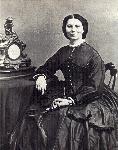Christopher “Kit” Carson (born Madison County, Kentucky, 1809; died Fort Lyon, Colorado, May 23, 1868) was a frontiersman and Indian agent. Children can learn more about him at: Kit Carson. They can also visit the Kit Carson Museum at: Kit Carson Museum.

Raggedy Ann and Raggedy Andy Meet for the First Time
Johnny Gruelle (born Arcola, Illinois,1880; died Miami Beach, Florida, January 8, 1938) was a children’s author and illustrator. He created the Raggedy Ann doll and the Raggedy Ann stories. He patented the doll in 1915; children can see the: Patent. Children can learn more at: Johnny Gruelle.
James Prescott Joule (born Salford, Lancashire, England, 1818; died Cheshire, England, October 11, 1889) was a scientist. He formulated Joule’s Law in 1840. An electrical conductor produces heat. The unit of energy is called a joule. Children can set up an experiment with a toaster to show how an electrical conductor carries heat. The children could enjoy the toast after the experiment. Children can learn more at: James Prescott Joule.
William Paterson (born Northern Ireland, 1745; died Albany, New York, September 9, 1806) represented New Jersey at the Constitutional Convention. A lawyer, he was part of New Jersey’s law making system during the Revolutionary War. After the war, he served in the Senate. Then he became governor of New Jersey. Then George Washington asked him to serve on the Supreme Court, a role he held for thirteen years until his death. Children could learn more at: William Paterson.
 Benjamin Rush (born Byberry, Pennsylvania, 1745; died Philadelphia, Pennsylvania, April 19, 1813) was an early American hero. He signed the Declaration of Independence. A physician, he was also called the “Father of Psychiatry.” He was the first doctor to label alcoholism as a disease. Children could learn more at: Benjamin Rush.
Benjamin Rush (born Byberry, Pennsylvania, 1745; died Philadelphia, Pennsylvania, April 19, 1813) was an early American hero. He signed the Declaration of Independence. A physician, he was also called the “Father of Psychiatry.” He was the first doctor to label alcoholism as a disease. Children could learn more at: Benjamin Rush.
John Langstaff (born Brooklyn, New York, 1920; died Basel, Switzerland, December 13, 2005) was a musician, music educator, and writer of children’s books. He wrote 25 children’s books, including Frog Went A-Courtin’. The book’s illustrator, Feodor Rojankovsky, received the 1956 Caldecott Medal.
Stephenie Meyer (born Hartford, Connecticut, 1973) writes books for young adults and produces movies. She wrote the Twilight series, The Host, and The Chemist. Older children can visit her website at: Stephenie Meyer.
Feodor Rojankovsky (born Mitava, Russia, 1891; died Bronxville, New York, October 12, 1970) wrote and illustrated books for children. He illustrated more than 100 books. His illustrations in John Langstaff’s Frog Went A-Courtin’ earned him the 1956 Caldecott Medal. Children can learn more at: Feodor Rojankovsky.
Noel Streatfeild (born Sussex, United Kingdom, 1895; died London, United Kingdom, September 11, 1986) wrote at least 28 books for children and at least 28 novels for adults. she also wrote some non-fiction. She is most famous for her “Shoes” books, including Ballet Shoes and Party Shoes. Children can learn more at: Noel Streatfeild.


 Benjamin Rush (born Byberry, Pennsylvania, 1745; died Philadelphia, Pennsylvania, April 19, 1813) was an early American hero. He signed the Declaration of Independence. A physician, he was also called the “Father of Psychiatry.” He was the first doctor to label alcoholism as a disease. Children could learn more at:
Benjamin Rush (born Byberry, Pennsylvania, 1745; died Philadelphia, Pennsylvania, April 19, 1813) was an early American hero. He signed the Declaration of Independence. A physician, he was also called the “Father of Psychiatry.” He was the first doctor to label alcoholism as a disease. Children could learn more at: 

